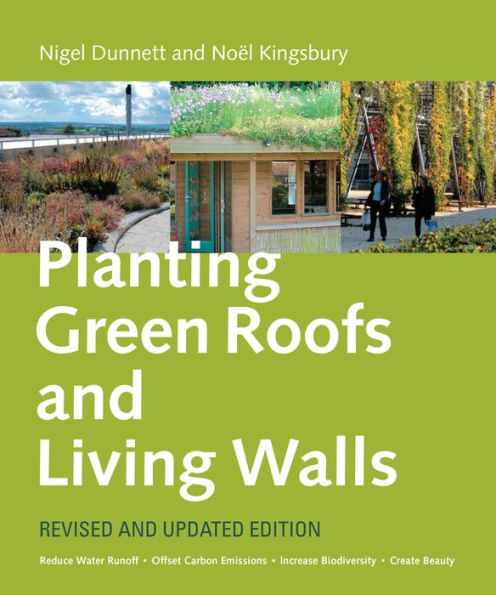

Hardcover(Revised)
-
SHIP THIS ITEMTemporarily Out of Stock Online
-
PICK UP IN STORECheck Availability at Nearby Stores
Available within 2 business hours
Related collections and offers
Overview

Product Details
| ISBN-13: | 9780881929119 |
|---|---|
| Publisher: | Timber Press, Incorporated |
| Publication date: | 04/15/2008 |
| Edition description: | Revised |
| Pages: | 256 |
| Product dimensions: | 8.00(w) x 9.50(h) x 1.06(d) |
About the Author
Nigel Dunnett is a Reader in Urban Horticulture in the landscape department at the University of Sheffield, where he has developed innovative research programs on naturalistic and ecologically informed planting for gardens and public landscapes. He is director of The Green Roof Centre, Sheffield, and acts widely as a consultant on green roof design and planting, and sustainable garden and landscape design in general.
He writes regularly for landscape and garden publications, including Gardens Illustrated and The Garden. With Noël Kingsbury he wrote Planting Green Roofs and Living Walls; with Andy Clayden, Rain Gardens: Managing Water Sustainably in the Garden and Designed Landscape.
Noel Kingsbury is a researcher, writer, and teacher. A gardener since childhood, he has run a nursery, designed gardens and public spaces, and done doctoral research at the University of Sheffield’s Department of Landscape on the ecology of ornamental perennials. He lives and gardens in the Welsh Borders near Hay-on-Wye.
Read an Excerpt
The contemporary use of plants on roofs and walls is distinguished from previous uses by the integration of planting and its supporting structures with the construction of the buildings themselves, as well as the use of modern materials. The result is a dovetailing of living plants, the building, and its human users, a closeness and integration not easy to achieve with older construction technologies. It is important to appreciate the distinction between older technologies of plant use and the new.
Old-style roof gardens either restricted the planting to containers and planters or used a layer of soil spread onto a roof surface, which had to be massively stronger than would otherwise need to be the case. New-style roof greening recognizes two distinct approaches, intensive and extensive.
Intensive roof greening is similar to the old-style roof gardens, where it is expected that people would use the area much as a conventional garden. Plants are maintained on an individual basis in the same way as they would in a garden at ground level. Soil depth is generally at least 15 cm (6 in) deep, but now may be composed of lightweight growing media, and is thus more correctly known as substrate. Simple intensive green roofs are covered with lawns or ground covering plants that still require regular maintenance, but have thinner substrates and are therefore less costly to install. Access may be possible, but generally these roofs are intended to be overlooked (English Nature 2003).
Extensive roof greening is not intended for regular human usage and may not even be intended to be seen on a regular basis. Plants are treated en masse, rather as grass plants are in a lawn. Any maintenance operation is carried out on them all simultaneously, such as mowing. In any case, maintenance is generally designed to be minimal. Substrate depth can be between 2 and 15 cm (0.8 and 6 in), which reduces the amount of extra loading that must be build onto the roof construction.
Ecoroof is a term used in some places as a substitute for green roof. Some people use the name to describe vegetated roofs as a way to distinguish them from other types of roof that may have an ecological function (such as roofs covered with photovoltaic cells) that can also be called green roofs (using the word green in its popular ecological or environmental sense). Ecoroof has also been taken up as a descriptive term for extensive green roofs in climates that experience very dry periods that cause vegetation to brown or ripen. For example, extensive green roofs in the city of Portland, Oregon, are referred to as ecoroofs because they are not green but brown for much of the growing season and therefore the term green is seen as a misnomer.
Brown roof is a term to describe roofs that have been covered with substrate or loose material but have not been purposefully planted. Brown roofs are created primarily for biodiversity purposes and aim to recreate typical brownfield conditions through the use of by-products of the development of urban sites: brick rubble, crushed concrete, and subsoils. Such roofs may colonize spontaneously with vegetation but the unvegetated loose substrates can also provide habitat for a range of invertebrates and birds.
Table of Contents
Introduction
Why build green roofs?
Constructing green roofs
Planting green roofs
Façade greening
Living walls, structures, and surfaces
Conclusion
Roof-greening plant directory
Suppliers
Bibliography
Further reading
Index








